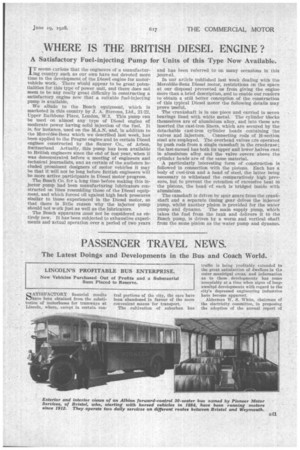_WHERE IS THE BRITISH DIESEL ENGINE?
Page 67

If you've noticed an error in this article please click here to report it so we can fix it.
A Satisfactory Fuel-injecting Pump for Units of this Type Now Available.
IT seems curious that the engineers of a manufacturling country such as our own have not devoted more time to the development of the Diesel engine for motorvehicle work. There wbuld appear to be great potentialities for this type of power unit, and there does not seem to be any really great difficulty in constructing a satisfactory engine now that a suitable fuel-injecting pump is available.
We allude to the Bosch equipment, which is marketed in this country by J. A. Stevens, Ltd., 21-22, 'Upper Rathbone Place, London, W.I. This pump can be used on almost any type of Diesel engine of moderate power having solid injection of the fuel. It is, for instance, used on the M.A.N. and, in additien to the Mereccdes-Benz which we described last week, has been applied to the Prague engine and to certain Diesel engines constructed by the Saurer Co., of Arbon, Switzerland Actually, this pump has been available to British engineers since the end of last year, when it was demonstrated before a meeting of engineers and technical journalists, and as certain of the audience included prominent designers of motor vehicles it may be that it will not be long before British engineers will be more active participants in Diesel motor progress.
The Bosch Co. for a leng time before making this injector pump had been manufacturing lubricators constructed on lines resembling those of the Diesel equipment, and which forced oil against high back pressures similar to those experienced in the Diesel motor, so that there is little reason why the injector pump should not work just as well as the lubricators.
The Bosch apparatus must not be considered as entirely new. It has been subjected to exhaustive experiments and actual operation over a period of two years and has been referred to on many occasions in this journal.
In our article published last week dealing with the Merceas-Benz Diesel motor, restrictions on the space at our disposal prevented us from giving the engine More than a brief description, and to enable our readers to obtain a still better conception of the construction of this typical Diesel motor the following details may prove useful,
The crankshaft is in one piece and carried in seven bearings lined with white metal. The cylinder blocks themselves are of aluminium alloy, and into these are inserted the cast-iron liners, which are secured by the detachable cast-iron cylinder heads containing the valves and injectors. Connecting rods of H-section steel are employed. The overhead valves are operated by push rods from a single camshaft in the crankcase; the last-named has both its upper and lower halves cast in aluminium alloy and the valve covers above the cylinder, heads are of the same material.
A particularly interesting form of construction is followed in connection with the pistons. Each has a body of cast-iron and a heed of steel, the latter being necessary to withstand the comparatively high pressure, but to prevent the retention of excessive heat in the pistons, the head of each is bridged inside with aluminium.
The camshaft is driven by spur gears from the crankshaft and a separate timing gear drives the injector pump, whilst another pinion is provided for the water pump and dynamo. The main supply pump, which takes the fuel from the tank and delivers it to the Bosch pump, is driven by a worm and vertical shaft from the same pinion as the water pump and dynamo.




















































































































